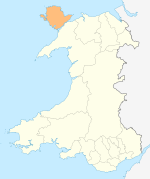|
Porth Wen Brickworks
Porth Wen Brickworks first built by Charles E Tidy, is now a disused Victorian brickworks which produced fire bricks, made from quartzite (silica) used to line steel-making furnaces. The substantial remains include a number of buildings and the remains of some of the machinery, but has some damage from sea erosion. The site is a scheduled monument. LocationThe brickworks is in a spectacular location on the western side of Porth Wen (English: White Bay) in the community of Llanbadrig in the north of Anglesey, and is about 2 km (1.2 miles) west of Porth Llechog and 3 km (1.9 miles) north-east of Cemaes.[1][2] The brickworks was established because of the readily available quartzite from the nearby quarries, a major component of fire bricks.[3] As with much of coastline of Anglesey, the brickworks lies within the area of the Anglesey Area of Outstanding Natural Beauty.[4] DescriptionPorthwen Brickworks includes quarries, an incline tramroad to the works, and includes a crushing house, moulding shed, drying sheds, and kilns. The brickmaking operation was supported by storage hoppers, engine house, boiler house, chimneys, warehouse and a quay.[5] Brickmaking started on the site in the mid 19th century, with the tramroad being added later, and the existing buildings being built in the early 20th century.[6] Although the brickworks ceased production in the first half of the 20th century (sources vary on the date; either 1924 or 1949),[1][6] the buildings and much of the equipment remain in situ, and the site shows:
Quarries and incline The brickworks were supplied from two quarries to the north-west of the works.[8][9] A tramroad from one of the quarries leading to a winding house and incline was shown on the 1st edition OS map, 1889.[10] The winding house includes two lateral walls of mortared walls of rubble masonry supporting a square drive shaft and bearings. The remains of the walls are splayed at the bases and roughly 4.5 m (10 feet) in length, 0.95 m (3 feet) wide up to a height of 3 m (10 feet).[10][11] The drive shaft supported three wheels each with eight spokes. One wheel is roughly 2 m (7 feet) in diameter and the other two are 1.5 m (5 feet) in diameter. The larger wheel was a banding-break and the other two were driving wheels for lowering and raising trucks on the incline. A wooden beam with a control mechanism remains in front the drive shaft. A second similar wooden beam lies nearby but is no longer in position.[10][11][12] Near the winding house are the remains of a storage shed roughly 4 m (10 feet) by 5 m (20 feet) with walls that supported a gabled roof of profiled sheeting and is probably more recent than the winding house, built in a period of improvement in the early 20th century.[13] The incline consisted of two tracks which have been removed but the track bed remains with retaining walls of random rubble masonry roughly 1 m (3 feet) deep. The incline was gravity powered.[12][14] Brickmaking The incline terminated at a crushing house where pieces of quartzite were broken up with a knapping machine. The pieces were passed down chutes to lower levels for further processing, resulting in a fine powder at the lowest stage. It is likely that the pieces of quartzite were reduced by hammer with the workers wearing iron covered gloves.[1][15][16] The resulting powder was mixed with lime and water in a pan mill. The resulting paste was then moulded and pressed into bricks in the moulding shed, and then dried out in drying sheds.[1][17][18][19] Originally bricks were made using moulding and wire cutting, but were later made using a press.[16] After drying, the bricks were then fired in one of the three circular down-draught kilns (also known as beehive or Newcastle kilns), made of brick with iron bands and domed roofs.[20][21][22][1][7] The brickworks also includes the remains of a boiler house, which contained a Five-drum Stirling boiler, and a small engine house for a steam engine.[23][24] Storage and distributionAfter firing, the bricks were stored in the main building, a two-storey brick building, with gabled ends.[25] Bricks were then loaded onto ships, using a crane, moored at the loading quay.[26][27] HistoryPorth Wen brickworks was designated as a scheduled monument by Cadw in 1986 and classified as a post-medieval industrial brickworks.[28] See alsoWikimedia Commons has media related to Porth Wen. References
Further reading
External links
Information related to Porth Wen Brickworks |
||||||||||||||||||||||||


